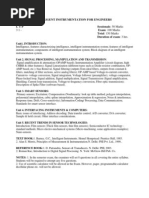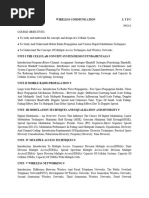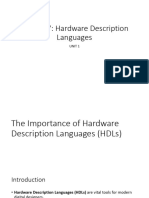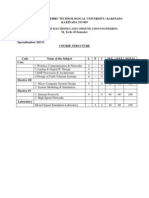0%(1)0% found this document useful (1 vote)
735 viewsAnalog To Digital Interfaces
This document outlines the topics to be covered in a course on analog to digital interfaces. The course will cover sample and hold circuits, switched capacitor circuits and comparators, digital to analog conversion, analog to digital conversion, and precision techniques. The objectives are to understand sampling analog signals for digitization, analog to digital and digital to analog conversion principles, and calibration techniques for precision data conversion. The course will consist of 5 units covering these topics over 45 periods to enable students to design data converters based on precision requirements.
Uploaded by
mohandossCopyright
© © All Rights Reserved
Available Formats
Download as DOCX, PDF, TXT or read online on Scribd
0%(1)0% found this document useful (1 vote)
735 viewsAnalog To Digital Interfaces
This document outlines the topics to be covered in a course on analog to digital interfaces. The course will cover sample and hold circuits, switched capacitor circuits and comparators, digital to analog conversion, analog to digital conversion, and precision techniques. The objectives are to understand sampling analog signals for digitization, analog to digital and digital to analog conversion principles, and calibration techniques for precision data conversion. The course will consist of 5 units covering these topics over 45 periods to enable students to design data converters based on precision requirements.
Uploaded by
mohandossCopyright
© © All Rights Reserved
Available Formats
Download as DOCX, PDF, TXT or read online on Scribd
You are on page 1/ 1
VL5301 ANALOG TO DIGITAL INTERFACES LTPC
3 0 0 3 OBJECTIVES To understand the importance of sampling the input analog signal for
digitization and enabling circuit architectures To understand the principles of Analog to Digital and
Digital to Analog conversion of signals. To understand the importance of calibration techniques for
achieving precision during data conversion
UNIT I SAMPLE AND HOLD CIRCUITS 9 Sampling
switches, Conventional open loop and closed loop sample and hold architecture, Open loop
architecture with miller compensation, multiplexed input architectures, recycling architecture
switched capacitor architecture.
22
UNIT II SWITCHED CAPACITOR CIRCUITS AND COMPARATORS 9 Switched-
capacitor amplifiers, switched capacitor integrator, switched capacitor common mode feedback.
Single stage amplifier as comparator, cascaded amplifier stages as comparator, latched comparators.
UNIT III DIGITAL TO ANALOG CONVERSION 9 Performance
metrics, reference multiplication and division, switching and logic functions in DAC, Resistor ladder
DAC architecture, current steering DAC architecture.
UNIT IV ANALOG TO DIGITAL CONVERSION 9 Performance
metric, Flash architecture, Pipelined Architecture, Successive approximation architecture, Time
interleaved architecture.
UNIT V PRECISION TECHNIQUES 9
Comparator offset cancellation, Op Amp offset cancellation, Calibration techniques, range overlap
and digital correction. TOTAL: 45 PERIODS OUTCOMES: To be able to design Analog to Digital and
Digital to Analog data converters based on data precision requirements
REFERENCE: 1. Behzad Razavi, “Principles of data conversion system design”, S. Chand and company
Ltd, 2000.
You might also like
- Remotely Controlled Android Based Electronic Notice BoardNo ratings yetRemotely Controlled Android Based Electronic Notice Board27 pages
- An Energy-Efficient and Robust 10T SRAM Based In-Memory Computing ArchitectureNo ratings yetAn Energy-Efficient and Robust 10T SRAM Based In-Memory Computing Architecture6 pages
- 2... Vijay-Advanced Security Systems in Jewellery Shops and Banks PDFNo ratings yet2... Vijay-Advanced Security Systems in Jewellery Shops and Banks PDF97 pages
- dorabot_io_1732959292_A_Seminar_project_report_bhupendraNo ratings yetdorabot_io_1732959292_A_Seminar_project_report_bhupendra19 pages
- Fingerprint Authentication: Name - Gaurav Singh Shekhawat ROLL NO. - 18EEBCS022No ratings yetFingerprint Authentication: Name - Gaurav Singh Shekhawat ROLL NO. - 18EEBCS02214 pages
- Experiment No 6: Implementation of Instruction Fetch Unit: Team Details: Terminal No: SL No Name Id No 1 2 3No ratings yetExperiment No 6: Implementation of Instruction Fetch Unit: Team Details: Terminal No: SL No Name Id No 1 2 36 pages
- Interview Questions With Answers: Ch.V.V.RamanaNo ratings yetInterview Questions With Answers: Ch.V.V.Ramana16 pages
- What Are The Questions Asked by MG Motors in Written Test in Previous YearNo ratings yetWhat Are The Questions Asked by MG Motors in Written Test in Previous Year2 pages
- Designing An FPGA-Based Reader - ArticuloNo ratings yetDesigning An FPGA-Based Reader - Articulo4 pages
- Questions From 10 Question Papers: Module 1: Number Systems and CodesNo ratings yetQuestions From 10 Question Papers: Module 1: Number Systems and Codes4 pages
- M.tech CPLD & Fpga Architecture & ApplicationsNo ratings yetM.tech CPLD & Fpga Architecture & Applications1 page
- Advanced VLSI Architecture Design For Emerging Digital SystemsNo ratings yetAdvanced VLSI Architecture Design For Emerging Digital Systems78 pages
- 34 Top Electronic Device and Circuits Lab Viva Questions and Answers Electronic Device and Circuits Lab Viva QuestionsNo ratings yet34 Top Electronic Device and Circuits Lab Viva Questions and Answers Electronic Device and Circuits Lab Viva Questions7 pages
- Power Optimization For Low Power VLSI CircuitsNo ratings yetPower Optimization For Low Power VLSI Circuits4 pages
- Ec8751 Optical Communication LTPC3003 ObjectivesNo ratings yetEc8751 Optical Communication LTPC3003 Objectives2 pages
- Algoritham and Architectural Level MethodologiesNo ratings yetAlgoritham and Architectural Level Methodologies44 pages
- Cycle-I: Computer Communication Networks Lab Manual (18TE63), 2020-2021No ratings yetCycle-I: Computer Communication Networks Lab Manual (18TE63), 2020-202177 pages
- PMOS, NMOS and CMOS Transmission Gate Characteristics.No ratings yetPMOS, NMOS and CMOS Transmission Gate Characteristics.13 pages
- Vlsi Application: Applications of VLSI Circuits To Medical ImagingNo ratings yetVlsi Application: Applications of VLSI Circuits To Medical Imaging4 pages
- Unit 1 - Hardware Description LanguagesNo ratings yetUnit 1 - Hardware Description Languages24 pages
- EC8353 Electron Devices and Circuits - Course Page - College WebsiteNo ratings yetEC8353 Electron Devices and Circuits - Course Page - College Website4 pages
- Design and Simulation of DAC On The Basis of Capacitor ArrayNo ratings yetDesign and Simulation of DAC On The Basis of Capacitor Array4 pages
- W.E.F. 2009-10 Jawaharlal Nehru Technological University: Kakinada KAKINADA 533 003No ratings yetW.E.F. 2009-10 Jawaharlal Nehru Technological University: Kakinada KAKINADA 533 00317 pages
- Noc Basics: 2.1 Noc Structure and Design SpaceNo ratings yetNoc Basics: 2.1 Noc Structure and Design Space15 pages
- Electrical Characteristics of MOS Devices: V + "Metal" Oxide V +No ratings yetElectrical Characteristics of MOS Devices: V + "Metal" Oxide V +36 pages































































